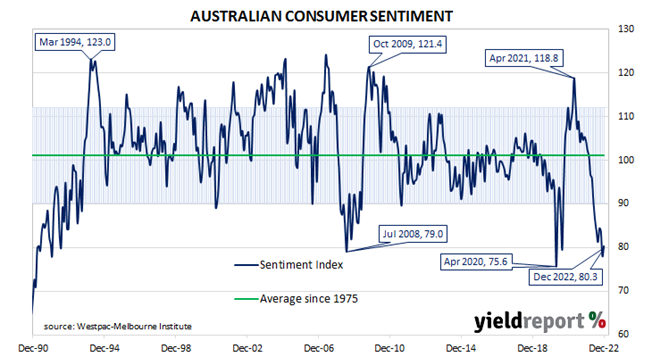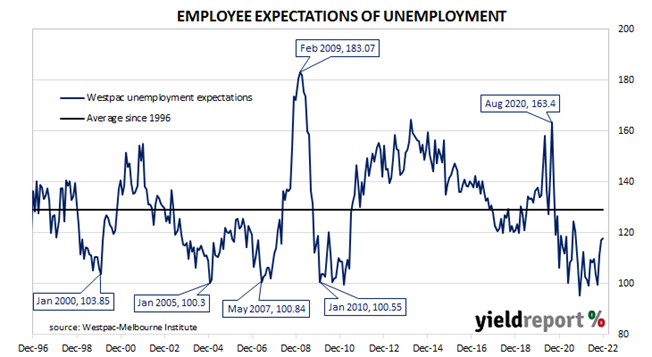Summary: Household sentiment improves in December; still comparable with COVID lows, GFC despite lift; three of five sub-indices higher; more respondents expecting higher jobless rate.
After a lengthy divergence between measures of consumer sentiment and business confidence in Australia which began in 2014, confidence readings of the two sectors converged again in mid-July 2018. Both measures then deteriorated gradually in trend terms, with consumer confidence leading the way. Household sentiment fell off a cliff in April 2020 but, after a few months of to-ing and fro-ing, it then staged a full recovery. However, consumer sentiment has deteriorated significantly over the past year, while business sentiment has been more robust.
According to the latest Westpac-Melbourne Institute survey conducted in the week beginning 5 December, household sentiment has improved. Their Consumer Sentiment Index rose from November’s reading of 78.0 to 80.3, a reading which is still well below the “normal” range and significantly lower than the long-term average reading of just over 101.
“Despite this welcome lift the level of the Index remains comparable with the lows seen during the COVID pandemic and the Global Financial Crisis,” said Westpac Chief Economist Bill Evans. “December’s 3% rise follows a disastrous 6.9% drop in November that saw the Index collapse to just 78, one of the weakest reads recorded outside of a recession.”
Any reading of the Consumer Sentiment Index below 100 indicates the number of consumers who are pessimistic is greater than the number of consumers who are optimistic.
Commonwealth Government bond yields moved higher on the day. By the close of business, the 3-year ACGB yield had gained 5bps to 3.13%, the 10-year yield had inched up 1bp to 3.40% while the 20-year yield finished 2bps higher at 3.73%.
In the cash futures market, expectations regarding future rate rises firmed slightly. At the end of the day, contracts implied the cash rate would rise from the current rate of 3.06% to average 3.18% in February and then increase to an average of 3.295% in May. August 2023 contracts implied a 3.65% average cash rate while November 2023 contracts implied 3.64%.
Three of the five sub-indices registered higher readings, with the “Family finances – next 12 months” sub-index posting the largest monthly percentage gain.
The Unemployment Expectations index, formerly a useful guide to RBA rate changes, rose from 117.3 to 117.9. Higher readings result from more respondents expecting a higher unemployment rate in the year ahead.



